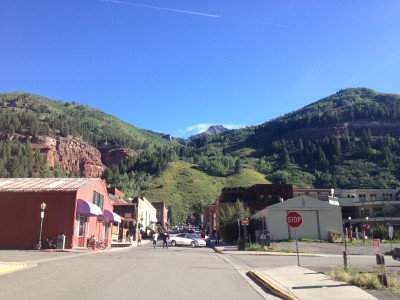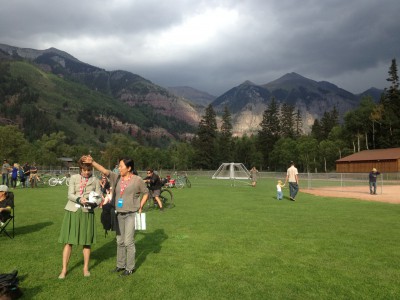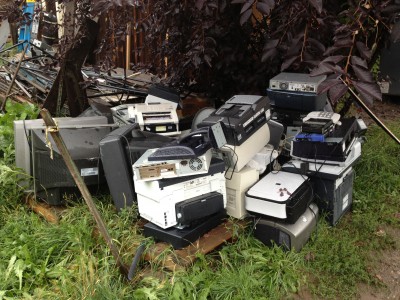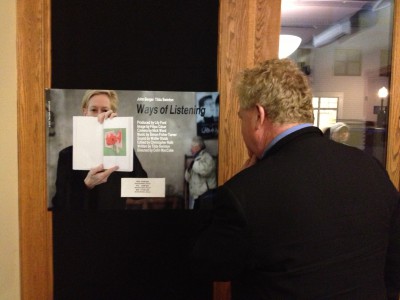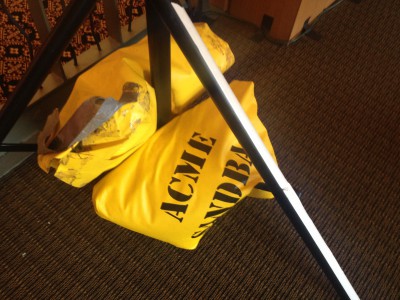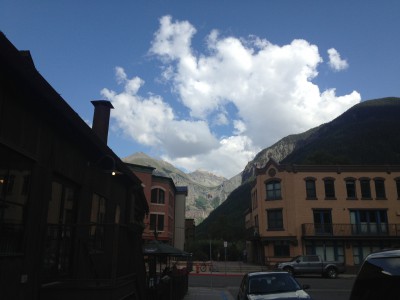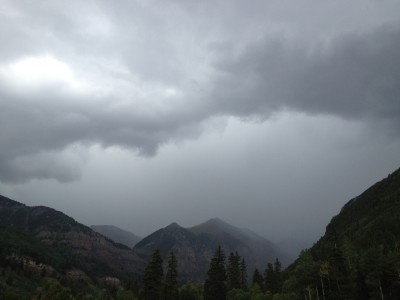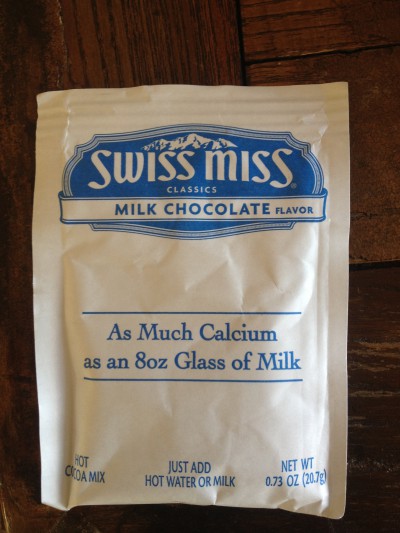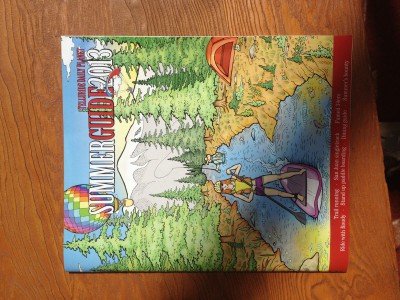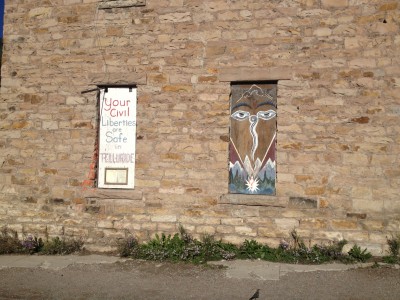Before the internet killed my TV, I used to watch a sports show called “Schwab uf Tour” (or was it Freestyle?) on the Swiss channel Star TV, in which host Marco Schwab was practicing and commenting on any kind of extreme sports. Besides the talking, which was complete nonsense, Schwab impressed me with one particular quality. Wherever he could, he did reverse somersaults into any kind of water. He jumped from cranes (10 meters), from power stations (14 meters), bridges (very high). A reverse somersault is a flip where you jump forwards and move backyards at the same time (the perfect image for our times?). The English word originates, at least according to Wikipedia, from the obsolete French word sombresault, Provencal sobresaut; and Latin – supra, over, and saltus, jump (done with copying). In German you call it, way more beautiful, an “Auerbach”. The Brockhaus encyclopaedia (read the related article in the Süddeutsche) tells us (or told us) that the name Auerbach originates from the German gym and sports teacher Wilhelm Auerbach, which I didn’t find more information on (sorry). 15 years ago, when I started doing my first attempts (clearly to impress girls, which worked – and works – quite well) almost nobody knew what an Auerbach was. It came out of nowhere, it hurt (usually). These days, Auerbach has become the norm, not the exception (you walk to the Bellevue in Zurich, and they guys there will give you some evidence). Yet, it has kept some of its romantic. One and a half year ago I went to see an exhibition of Lucien Freud in the National Portrait Gallery in London where they exhibited an incredible painting by Freud of Frank Auerbach, an English painter born in Berlin. Maybe he was a relative of Wilhelm Auerbach, the sports professor. I don’t know. Summer’s gone, the Auerbach will rest.

Lichten*berg
Lichtenberg is an Ortsteil of Berlin in the Bezirk of Lichtenberg. Until 2001 it was an autonomous district with the localities of Fennpfuhl, Rummelsburg, Friedrichsfelde and Karlshorst. The old part of Lichtenberg, now called Alt-Lichtenberg, was founded around 1230, due to the German colonization of the territory of Barnim. Lichtenberg suffered severely during the Thirty Years’ War and remained small at the gates of Berlin. In the late 18th century Prussian noblemen built their ugly residences in Lichtenberg and in 1815 it became a property of the Prussian chancellor Karl August von Hardenberg. In 1920, with the Greater Berlin Act (Groß-Berlin) Lichtenberg became part of (Groß-)Berlin. After the war it became part of the East and the Hauptstadt der DDR. The boarders of the city were around Fennpfuhl until most of the Plattenbauten in Hohenschönhausen and Marzahn were built during the 1980s. Lichtenberg is outside the S-Bahn-Circle, which means there are still affordable flats. Some of Berlin’s greatest attractions and sightseeing spots are the Tierpark Friedrichsfelde, ––the Eastern zoo––, and the Dong Xuang Center in the Industriepark Herzbergstraße. Until 2020, Berlin’s Vietnamese population will build its own Asia town here. Vietnam was a socialist ally to East Germany and most of the cheap labor immigrated in the 1970s and 1980s. Lichtenberg––like Kreuzberg for the Turks in the West––became their center. There is a special socialist vastness to this part of the City. A lot of space and enormous roads, many parks and artificial lakes, many dogs, many old people with rolators, a lot of concrete, a lot of Russians and less Nazis than you would expect. Recently, it was art collectors, investors and the architectural intelligenzia who discovered the area. And the urbanistic challenge is big indeed: How to convert a socialist utopia into a capitalist reality?! Some one like the architects lacaton & vassal are inspired by this challenge, they create indeed a vision for tomorrow from the Plattenbauten of the past. Berlin is less adventurous: The plan for an International Bauausstellung 2020 in Lichtenberg was cancelled. It will be up to others to figure out what Lichtenberg is, what it means, what it could be. It may be up to us.
Maybe it’s like that: There are two types of people, there are photographers and there is the rest of us. I always feel safe with photographers, I always feel that they know their way around, where to go after dark and where not to, what to drink, what to say, where to look – their’s is a radical openess and a certain neglect for the things that the rest of us want, safety, a warm bed, a wife, that sometimes leads them to different, darker pathways. James Nachtwey is one such example, we discussed his story while we were climbing up the road towards Shimla in the Indian Himalayas, lush green valleys and the sense of a colonial past lifting occasionally like the deep hanging clouds. What are you prepared to give, what are you prepared to offer, what is the price you are willing to pay? In the case of Nachtwey, the legendary war photographer, the answer was clear: anything, everything, my life, not for the thrill, not for the image, but for the idea that moves him – call it justice, call it humanity, call it the dream of a warm bed. And Enrico, as far as I can tell, is similar in that way. We only spent two days together, we drove to the former British mountain ressort of Shimla together to do a story for Der Spiegel and meet the brilliant writer Pankaj Mishra in his little village nearby – and different as we are, what I immediately liked about Enrico was the intensity of his thinking, the spiritually and ethically motivated way of looking at the world, the intimacy with which he engaged with the people around him. Enrico is a talker, he likes to communicate, and even the Indians were surprised as to how good his Hindi is. He is a person who thinks in stories, and one of these stories is his own life, which he changed within a few weeks: He had come to India, he felt the rest of his life crumble, the life of a software guy from Germany, a strange and empty shell that he left behind – and reinvented himself as a photographer. He just started, driven by his curiosity, to seek out the poorest of the poor, the lower casts, the drug addicts, follow them, live with them, spend time with them, this, he said, was the most rewarding thing, and he talked of friends. Today he works for the New York Times and does pro bono work, he lectures and travels to make people see and understand. What has not changed is the attitude: Born in the East of Germany, and a body full of tattoos, he will do anything, anything needed to make you aware.
First I met Anne here in Berlin. She didn’t fit. Walking down Ackerstraße in high heels and with perfect hair and a perfect dress was kind of a mismatch around 2001, 2002. And Ackerstraße was not Wedding or Kreuzberg. Mitte between Linienstraße and the Monbijoupark was always more Munich, more Milan, more Paris than the rest of the city. But it was not and never will be Los Angeles. Berlin is slow, suspicious of wealth, suspicious of fame, Berlin is jealous, Berlin is sour. And these were its great 10 years. Between 1996 and 2006. This was when every artist in the world would come to Berlin. We still had some bad art around und there were many cheap flats. Now everything looks the same and most of the younger people move on to Warsaw and Istanbul. Only the politicians, the families and the journalists stay.
Los Angeles is cheerful and sunny, Los Angeles is surf, Los Angeles is cars, Los Angeles is very superficial in a good way and porn in both ways––and it has “the industry”. It has this ability to create stars, to create dreams and narratives and stories. Not only in Hollywood. It has also the small stuff, the opponents, the weird, and Los Angeles has Steven Soderbergh (looking for a new grammar out there––versus “the tyranny of the narrative”) and Morrissey––and it has Anne Philippi. When I met her in the Chateau Marmont a few years ago I knew that she had found her place. And I love everything she writes. The homestory on James Ellroy, the BILD-thing on Berlusconi’s ridicules affair with an 18-year old, Myke Tyson on psychology, and James Franco on everything. Lindsay Lohan, Mike D, Peter Fonda and Phil Spector. And Anne had a blog from America: Miss Thomson for the German Rolling Stone. With fag in hand and in the spirit of Hunter S. I can’t wait to read her 60picks.

America can’t deal with Miley Cyrus and this picture shows us why.
1) M. will upset Disney, because they can’t forget about Hannah Montana (Miley’s old character as a child, that made them Billions and Billions) and naturally they would like her NOT to wear things like a comic body stocking. 2) M. will remind America that it can’t live without its Britneys and Lindsays in general and that it will create a new one, if the old one went to rehab. 3) M. will reach the poorest areas in South America and will tell girls and boys to come to the US under any circumstances (I’ve seen Miley on more cell phones in El Salvador then you can imagine 4) M. did and still does distract from Syria. 5) M. is upsetting, crazy making and attractive at the same time. 6) M. is a future main character in a Bret Easton Ellis novel. 7) You can’t love M. But you can’t blame her for this either. So America now has to deal with Miley.
When we met her—Lerato—she looked fabulous. Blue dress, dark sunglasses, and a furious crown of hair. She took us dancing. She showed us the Johannesburg she knows. “If you want to understand Johannesburg,” that‘s what our friend the philosopher Sarah Nuttall had told us a day before, “you have to go out. You have to let yourself be swept away.” So that‘s what we did. We got into a cab, drove through the dark deserted town, ignored all warnings, and found ourselves in a party more glamorous than either of us had ever been to, Bobby and me. Glamorous not in that Karl Lagerfeld-stupid sense, but young and beautiful and sexy and energetic. The music by DJ Fix was stellar. The setting was epic because of its glory in decay, a surge of enthusiasm that kept us partying till the early morning. The next day Lerato showed us her work. And this was when we finally fell for her. Because it’s not only strong and full of a longing that has to do with how things and people look, as well as with the understanding that the need to resist, the will to survive, the commitment to be a better person, is all a daily undertaking. No, the world she showed us, with these pictures, took us away from the present and then took that present and made it much stronger than almost anything we had seen ot done in Johannesburg. Cold, wonderful Johannesburg. City of fear and angels. We then asked her to contribute to Book 8 of the 80*81 series, the Superburg Book – and these pictures again show what an eye she has for the layers of the present, the pose of the political, the reference of the historical, the knowledge that something is ahead, we are just not sure what it is.
This is how it happens. One day you are fine, next day you are a speculative realist. One day you go out, next day you know Armen Avanessian. Ideas come and go, people come and go, but sometimes you know there had been a longing, a sense of loss and failure only after the fact, after you come across an idea, after you talk to a person. This was Armen, the most understated Austrian you can imagine, grey hair in a good way, metal glasses in a good way, serious in a good way, funny in a good way. Somebody you had been waiting for. You: The person from the 1980s, the 1990s, the pomo person, stuck in the irony, in the games, in the language that was everything and the reality that was nothing, even though you knew this was not true, and it was not everything that postmodernism was about, it was Derrida`s cruelty as well as Baudrillard`s circus, it was playful and beautiful and free, it was Lyotard and Lévinas and the Other, it was political, even if people do not want to see that anymore – but it was also over for a long time, over in a sense that it had not lost its meaning, but its relevance for today. The questions were different. So was postmodernism a failure? Armen would be sceptical about such a statement as he is sceptical about almost everything. But that is only on the surface, the calm, distinguished scholar who chooses to be on the outside of academia and publish one book after another with the still furious publishing people of Merve instead of boring students and himself to death with stuff that had been thought before. He is not actually a philosopher, he is a literature guy, but when he came across Quentin Meillassoux and all that had not been thought before in this and only this way – he was hooked. He is in a way the spokesman at least in Germany for this new philosophical movement, the first real movement since postmodernism and in a way about to do away with it: relativism, ontological mindlessness, a world that does not exist. The world does exist, very much so; it actually existed well before man and it will exist well after man. This is the starting point for the speculative realists. If philosophy after Kant claimed that we cannot say anything about the world that is not based on our very existence, on our very reason, then this is what Armen would call the correlationist folly. It is strange that philosophy has not been more shaken by all the discoveries that were made by Darwin, Einstein and the likes – but now is the time of reckoning. If we are not the center of the world, we cannot be the center of philosophy. This is a copernican moment. This is Armen`s game.
Chris Petit wrote a piece on Kraftwerk before Computerworld came out. “Am Diskö with Kraftwerk.” His interview with Robert Mitchum was a total failure until the moment he asked Mitchum about the hardest drink he’d ever had. The response filled five pages in Time Out. During the outbreak of the volcano Eyjafjallajökul Chris came to Zurich to visit Georg and me, from Buenos Aires––where he showed a retrospective of his work–– which took him more then two days. Most of the flights were cancelled because of the ashes. Chris just said, “The big lesson learned was never queue, because the person everyone is waiting to see doesn’t know anything either. So it became like an initiative test.” We both like slow motion. His friend and collaborator Iain Sinclair called him “J.G. Ballard on foot”. In January three years ago we went to Auschwitz. We didn’t know that January 27, the day we arrived from Berlin by car, was the anniversary of the liberation by Soviet troops in 1945. And we didn’t find the SS resort Solahütte on the Sola river, where Josef Mengele, Rudolf Höß, and Josef Kramer spent their weekends. We asked around in the area but everybody sent us somewhere else. The only thing we found was a pub called HATE. Chris Petit came to Johannesburg and we walked to Miniland. His latest ideas are the Museum of Loneliness and GooglemeGod. His first film was Radio On, his bestseller The Psalm Killer. His film Chinese Boxes from the mid-80s with Will Patton foresaw the fall of the Berlin wall. First the criminals reunite. I’m not sure but I think Chris does a lot of daytime TV: “I am always surprised at how sophisticated a lot of popular television is, not in terms of content, which no longer exists, but how much thought has gone into the format.”
Georg recently sent me a text message with two links. One leading to a 1994 muscle BMW 740 in this strange and seldom purple, the other link showed a brownish (bordo metallic) Lancia Thesis from 2003. The BMW is sporty, pimped too bully, the Thesis got the best name a car ever had (where is the Volkswagen Kant or the Peugeot Latour?) and is too retro. But it is Italian. German attack vs. Italian melancholic elegance. Impossible to decide which car Georg should drive. Both. These are the two complementary poles Georg thinks and writes between. He already owns a Volkswagen Beetle from the 1980s, a Range Rover without an engine, the American Gigolo’s Mercedes SL convertible and a black Vespa. And he loves car sharing. It is all there and it is all good. There is no dissent.
Georg and I started off playing tennis. No serves, after each player hits the ball twice we start counting. In New-Tennis volleys count double. We went to North Dakota to ask the British psychoanalyst Christopher Bollas why we had come all the way, we met the philosopher Michel Serres on a sunny Berlin day, and we went to Slavoj Zizek’s apartment in Ljubljana and spoke about nightmares. We sat in Françoise Barré–Sinoussi’s tiny office in the Pasteur Institute in Paris and talked about the worst diseases of all time. We published eleven books together always trying to find out What Happened in 1980/1981. We went to India to get rid of the monsters we had called. In the near future we celebrated the centennial of 80*81 and found the contemporary, this turned into the opera What Happened 2081? Neo-Yogaism, No More Men, and Algorithm. We organized walks and congresses in Berlin, in Johannesburg and in New Delhi. We buy a tower in Lichtenberg. We will get goates on a hill. We try #60.

Actually I have to go. It is the last day of the film festival. 8:30, I have a breakfast meeting in the Sheradon on Colorado Ave. The internet here in the Ice House is very slow. Later there is a picnic in Town Park. Tomorrow at 6:00am a bus will get us to Montrose airport, where the charter will get us to New York. In the charter I will have time to write about the 40th Telluride Film Festival in the mountains of Colorado. Her are some images, if they upload:
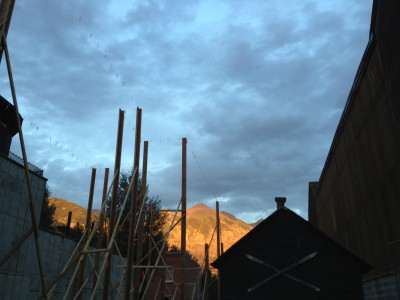
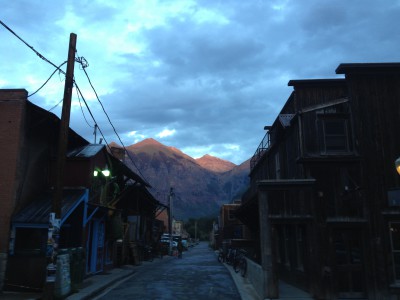
This is the new Werner Herzog Cinema for 650 people. The rest of the year the Werner Herzog is an ice skating venue:
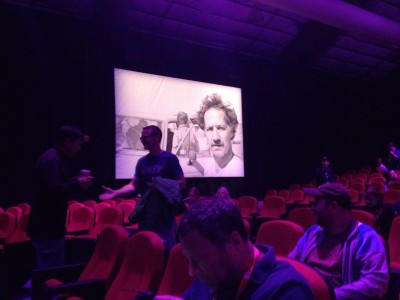
One more thing. This is a fruit I have never seen before. A cross between apricot and plum, the Dapple Dandy Pluot:
It’s sunny every morning and there is rain and thunderstorm every afternoon, so I bought this hat in the angler store: (not to put on outside the US)
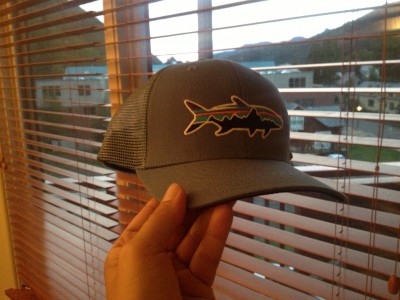
Now it is 12:14 Mountain Time and I found out it is Labor Day. I just went to a Q&A for the Cannes winner “Blue Is the Warmest Color”, also known as the lesbian porn, or “La Vie d’Adèle – Chapitres 1 & 2” –– directed by Abdellatif Kechiche, with Léa Seydoux, Adèle Exarchopoulos, Salim Kechiouche, and Jérémie Laheurte. The film is really good. And really long. Everybody complaines about the sex scenes. But the sex scenes are very good. Sex and art are hard to show in movies. Léa Seydoux plays an artist in the film and her art is really horrible. But the rest is very good. Why are there no mobile phones in the film?
Here they are with my friend Colin MacCabe translating the French (Léa Seydoux in a RUN DMC t-shirt):
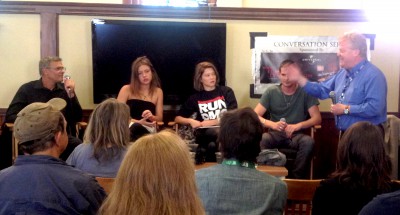
and here is the poster:
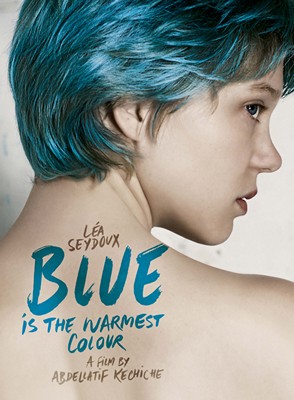
It’s 5:10pm Mountain Time. I just had lunch with Salman Rushdie. Colin is a very old friend of his. Salman told this nice strory about Ernest Hemingway’s A Moveable Feast. First of all it is “movable” not “moveable”, a mistake they took from Hemmingway’s notes because the book was published after his death. It’s full of Hemingway’s personal accounts, observations and stories of the 1920s in Paris. “If you are lucky enough to have lived in Paris as a young man, then wherever you go for the rest of your life, it stays with you, for Paris is a moveable feast.”
More tomorrow:
